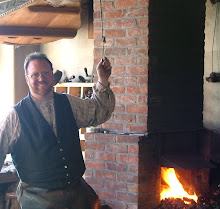All of the wooden parts and most of the bolts and brackets were rotten, rusted, worn or missing. Here is the original wooden beam. It still retained the holes and rust stains to indicate where hardware was missing. Our task became to figure out what parts were needed and to make them.
We set out to repair the plow using historically accurate methods and to put it back into use at The Farmers’ Museum. Farmer Wayne carved a replacement wooden plow beam by using the decayed original as a model. Here is the new beam and some of the newly forged bolts.
I made plow bolts, carriage bolts, and a 24-inch long by 1/4” stretcher bolt, and nuts. We also made the gauge wheel bracket.
Our last forging project is the largest. We are forging a replacement knife coulter blade. This is the part of the plow that cuts the sod and roots before the plow rolls the soil and sod over. It is a heavy piece. We have forged it using two and three smiths at a time. The finished part looks simple but will have taken about 16 hours of work.
This plow is a great example of plows as used in the 1830’s. It has probably not been used in the last 80 to 100 years. Our plowing is about to start. We plow our gardens, hop fields, potato field, and grain plots. Returning this piece of historic equipment to use has been a long road. My thanks to the farmers Rick, Wayne, and Marieanne for making this project possible. I think the farmers are even more excited than I about the chance to put the 1830’s plow to use!
The maiden voyage of this tool will involve adjusting the bite and the draft of the plow. That controlled the width of the plowed strip and the depth of cut. Zeb our Percheron draft horse will pull the plow for this test. It will be hard work, but he is a plowing veteran. This is his 13th year of plowing at The Farmers’ Museum.
After Zeb helps us to fine-tune the plow it will be used by our team of oxen. Jigs and Buckwheat have never had such an important and difficult job to do at the farm. They will earn their hay this summer!
Check back soon. We will post a video later this week of the 1830’s plow being used once again!









I am really interested in plowing. How do you know what the best, most easily repaired, most easy to use, smoothest cutting plow is? There are so many different kinds of horse plows invented by so many different people/different cultures how does one sort through it all and find the all around best one? I Love the ones you sit on that have more than one blade. Using your own weight to help turn the soil is so cleaver. But walk behind ones are awesome too. I really want to start plowing this way but I have no idea where to start. I would like to build my own plow too. So cool. Going to need an anvil I think... Welding wont be enough.
ReplyDeleteThanks in advance for any info or resources you could suggest.